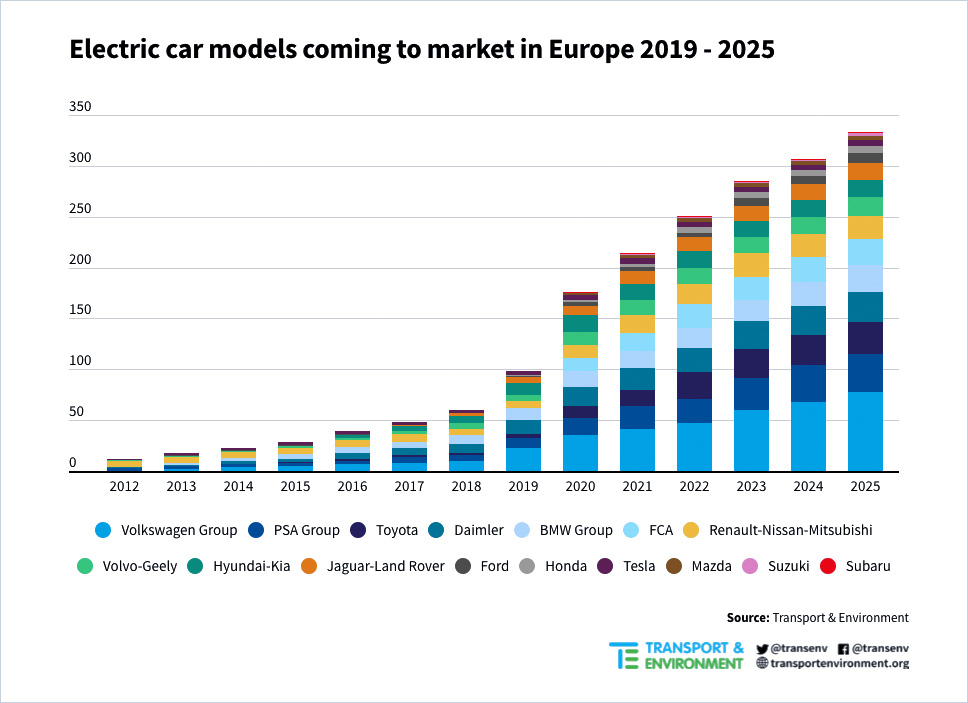Electric vehicles: basics on technology, range and co.
Are you considering purchasing an electric vehicle for your business? Read this blog post to find out what you should consider when buying or leasing an electric commercial vehicle.
The different forms of drive
Technologies such as mild hybrids or natural gas vehicles are not (yet) suitable for everyday use in a fleet. In contrast, the following drive forms have long been on our roads:
- Battery electric vehicles (BEV) run exclusively on battery power and use only the battery as an energy source.
- Hybrid vehicles (HEV) combine electric and combustion engines (mostly petrol).
- Plug-in hybrids (PHEV) use rechargeable batteries and can be charged externally from an external power source via a power supply unit.
- Fuel cell electric vehicles (FCEVs) generate electrical energy by reacting hydrogen with oxygen energy, but are not yet widespread.
Are purely electric cars lower in emissions than combustion engines?
In short: yes.
During the production process of batteies and e-vehicle, more CO2 emissions are generated compared to combustion cars. However, thanks to years of emission-free driving, pure electric vehicles (BEVs) have a lower overall CO2 balance. After all, internal combustion engines only use up to 50% of the energy in the fuel, whereas electric motors use between 80% and 100%.
How “green” they really are in the end depends particularly on the drive energy, i.e. with which electricity they are charged: With the current electricity mix, BEVs are only slightly more environmentally friendly than combustion engines and plug-in hybrids. With 100% green electricity, the CO2 savings would be up to 60%.
Therefore, do not look at the procurement of an electric vehicle in isolation and think about purchasing green electricity yourself and/or installing equipment such as solar panels. The Sortimo company has also ventured a step into the future here and has built an electric charging station at the Sortimo Innovation Park Zusmarshausen (SIZ), which is the largest in Germany and one of the largest in Europe. From the end of July, this will go into operation and will be powered purely by regenerative energy.
Advantages and disadvantages of a plug-in hybrid
Advantages:
- Independence from charging options no completely emission-free driving
- Similar subsidies as BEV
- higher ranges
Disadvantages due to the combination of combustion engine & electric motor:
- No completely emission-free driving
- Increased unladen weight and higher maintenance costs
- higher fuel costs due to petrol drive compared to diesel vehicles
Basically, plug-in hybrids should not be seen purely as an image enhancement or tax-saving model and should be driven exclusively with the combustion engine. The technology only makes sense and is more environmentally friendly than pure combustion engines if the electric motor is actually used and combined as intended.
The “problem” with range
It is a hotly debated topic and inhibits many in their decision to buy. Yet the range of an ordinary electric vehicle has long been sufficient for most everyday journeys. However, if the destination is hundreds of miles away, the public charging infrastructure is needed. Furthermore, the maximum distance that can be covered is by no means clearly determinable or exactly predictable. Many aspects play a role here, starting with the electric motor itself, the battery capacity or even external circumstances such as the weather. Tesla models, for example, have a range of up to 372 miles, while a Smart model has a range of around 62 miles. Commercial vehicles have a range of 74 miles to 230 miles.
But beware: one is not necessarily better than the other. When choosing a vehicle model, the range must fit and match your everyday driving habits including work and living circumstances.
Also, don’t forget that you yourself can concretely influence the range. Your own behavior and personal driving style are key factors – even more so than when driving a car with an internal combustion engine.
Therefore, you can gain range through a conscious driving style:
1. braking in an electric car is more efficient by taking your foot off the power pedal. The so-called recuperation even recovers energy.
2. accelerate slowly and deliberately.
3. vehicle weight and aerodynamics: electric motors work better the lighter and more streamlined the vehicle is. Pay attention to this, both when loading tools and materials on a daily basis and when choosing your van racking. Ask a Sortimo sales consultant for advice on load space optimisation and workplace organisation. There are many ways to optimise the weight of the installation and also to avoid transporting unnecessary materials by sorting tools and materials in a structured way. Read more about the 5S method.
4. Avoid unnecessary energy consumption: With the electric motor, there is no combustion, so there is no waste energy for heating and cooling so this can be a real power guzzler. Make sure the temperature is right before you start driving, while the vehicle is connected to the charging station.
When it comes to purchasing, pay attention to the tips above and consider the following additional points:
1. observe your driving behaviour to draw conclusions about what battery power you will need. Too little power will let you down, too much storage is a big cost driver in the purchase.
2. compare charging specifications to optimise the user experience.
3. broaden your supplier horizon.
Why e-vehicles are not just a ‘trend’
On 12 December 2015, history was made with the Paris Climate Agreement, when the global community decided on greenhouse neutrality by 2050. A turnaround is therefore also unavoidable for the third largest emitter of greenhouse gas emissions within the EU transport sector. Internal combustion engines will increasingly disappear from the roads – to be replaced by electric vehicles. With this in mind, Germany has set itself the goal of registering at least seven to ten million e-vehicles by 2030. The EU has held out the prospect of enforcing a ban on the production of combustion engines by 2035.

The transition is thus no longer far away in terms of time. Nevertheless, there is still a lot to be done and a clear rethink is necessary, even though a path towards e-vehicles has already been taken: in 2019, only 2% of all nearly 50 million registered passenger cars in Germany were alternatively powered, and even in 2020, only about 570,000 e-vehicles were on the road. But things are moving in the right direction: almost every third newly registered vehicle was electrically powered in 2020.
Similarly, vehicle manufacturers have dedicated themselves to the development of electric vehicles within their new models. The EU’s pre-announcement to stop producing combustion engines by 2023 is currently not meeting with any resistance from vehicle manufacturers, because they too are pushing development and have set themselves deadlines to say goodbye to the combustion engine. Until recently, the electric vehicle market was limited to a niche of early adopters. In the meantime, however, the tide has turned and the choice for users has increased significantly – it is heading towards mass production: in 2019, there were not yet 100 different models on the market, so the planning for 2021 is already at 176 models and is expected to rise to 333 models by 2025.

https://www.transportenvironment.org/publications/electric-surge-carmakers-electric-car-plans-across-europe-2019-2025 (retrieved 19.07.2021).
You can find an overview of the current electric vans in our blog post Overview of all electric vans.

 Shipping free of charge
Shipping free of charge  30 days return policy
30 days return policy  Climate-neutral online shop shipping
Climate-neutral online shop shipping  Free Hotline +44 (0)1925 / 831 636
Free Hotline +44 (0)1925 / 831 636 
There are no comments yet. Be the first!
We look forward to receiving your feedback on this post.